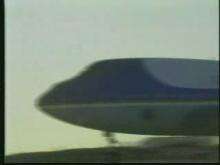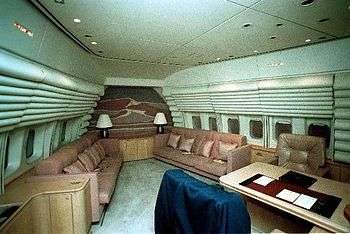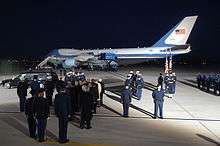Boeing VC-25
| VC-25 | |
|---|---|
 | |
| A VC-25 over Mount Rushmore in February 2001 | |
| Role | Presidential transport |
| Manufacturer | Boeing |
| First flight | May 16, 1987 |
| Introduction | August 23, 1990 |
| Status | In service |
| Primary user | United States Air Force |
| Produced | 1986–90 |
| Number built | 2 |
| Unit cost |
US$325 million |
| Developed from | Boeing 747-200B |
The Boeing VC-25 is a military version of the Boeing 747 airliner, modified for presidential transport and operated by the United States Air Force as Air Force One, the call sign of any U.S. Air Force aircraft carrying the President of the United States.
Only two examples of this aircraft type exist; they are highly modified Boeing 747-200B, designated VC-25A and having tail numbers 28000 and 29000. Although technically the Air Force One designation applies to the aircraft only while the President is on board, the term is commonly used to refer to the VC-25 in general. The two aircraft often operate in conjunction with Marine One helicopters, which ferry the President to airports whenever a vehicle motorcade would be inappropriate.
Development
By 1985, the pair of Boeing 707-based VC-137s used as the Presidential aircraft had been in service for 23 and 13 years respectively, and the USAF began searching for an eventual replacement. The Request for Proposal issued stated that the aircraft to be selected should have at least three engines and an unrefueled range of at least 6,000 miles (9,700 km). Both Boeing with its 747 and McDonnell Douglas with the DC-10 were in competition to be selected, with the Boeing entry the eventual winner.[1] The fabrication of the current 747s began during the presidency of Ronald Reagan (1981–1989). Reagan ordered two identical Boeing 747-200Bs to replace the Boeing 707s that he used for transport.[2]

The VC-25s were completed in 1986 and first flew in 1987.[3] The interior designs were created by First Lady Nancy Reagan, who used designs reminiscent of the American Southwest.[2] Problems with interior wiring for communication systems delayed delivery of the two aircraft until 1990,[3] during the administration of George H.W. Bush.
The VC-25 is not compliant with Automatic Dependent Surveillance Broadcast (ADS-B) standards; the Air Force is upgrading both airplanes. The Air Force reported that the operating cost for each VC-25A is $210,877 per hour.[4]
Design and configuration
While the VC-25 has two main decks and a cargo area, like a regular Boeing 747, its 4,000 square feet (370 m²) of floor space has been reconfigured for presidential duties. Its lowest level is mostly cargo space, carrying luggage and the onboard food supply.
The main passenger area is on the second floor or main deck.[5] There are three entrances on board, two on the lower and one on the main deck. Typically the president boards and deplanes from the front, main deck entrance via an airstair, while journalists and other passengers enter at the rear door of the main deck. Facilities for the press and other passengers are configured like an ordinary airliner's first-class cabin.[6]
"The White House"





The front of the aircraft is referred to as the "White House" of the aircraft.[5] The president's executive suite includes sleeping quarters with two couches that can be converted into beds, lavatory and shower, vanity, double sink, and a private office, or the president's "Oval Office aboard Air Force One". If necessary, the president can address the nation from the office. This capability was added after the September 11 attacks, during which the aircraft had to land at Barksdale Air Force Base in order for President George W. Bush to address the nation.[7] These offices, including the president's suite, are mostly located on the starboard (right) side, and a long corridor runs along the port (left) side. There is an area along the corridor for two Secret Service agents. The aircraft also contains a conference room, originally designed as a situation room but now used for meeting with staff while traveling. This room includes a 50-inch plasma screen television which can be used for teleconferencing. The aircraft has fully equipped office areas with telecommunication systems (including 87 telephones and 19 televisions).[5]
On board the VC-25 is a medical annex, which includes a fold-out operating table, emergency medical supplies, and a well-stocked pharmacy; George W. Bush had a treadmill added to Air Force One during his term in office. Every flight is staffed by a doctor and nurse. The aircraft is self-sufficient, such as carrying all the food it will need. Meals are prepared in two galleys, which together are equipped to feed up to 100 people at a time.[5] The President gets his own menu. An area where guests sit is near the center of the aircraft, outside the "White House".[5]
There are separate quarters for guests, senior staff, Secret Service and security personnel, and the news media located in the aft area of the main deck. Protocol states that one may wander aft of wherever one's assigned seat is, but not forward.[5] Communications equipment and the cockpit are on the upper deck. There are also secure and non-secure voice, fax and data communications facilities.[5] While the aircraft's luggage capacity is adequate to carry the belongings of the passengers, the logistics train of the President means that the aircraft must fly preceded by an aerial convoy of several cargo transports, which carry the helicopters, motorcade vehicles, and other equipment required by the presidential entourage.[5]
The VC-25 is capable of flying 7,800 miles (12,600 km)—roughly one-third the distance around the world—without refueling. It can be refuelled during flight from a tanker aircraft. The VC-25A can accommodate more than 70 passengers. Each VC-25A cost approximately US$325 million. When a VC-25 taxis to an airport's ramp for events, it stops with the port side of the aircraft facing gathered onlookers.
Operational history
The VC-25 replaced the VC-137C (a military version of the Boeing 707) as the mainstay of the Air Force One fleet. On some occasions, the VC-25s are used to transport the Vice President of the United States, for which service they adopt the call sign Air Force Two. These aircraft are maintained and operated as military operations by the Presidential Airlift Group, part of Air Mobility Command's 89th Airlift Wing, based at Andrews Field in Camp Springs, Maryland.
.jpg)

The aircraft can also be operated as a military command center in the event of an incident such as a nuclear attack. Operational modifications include aerial refueling capability and anti-aircraft missile countermeasures. The electronics on board are connected with approximately 238 miles (383 km) of wiring, twice that of a regular 747. All wiring is covered with heavy shielding for protection from an electromagnetic pulse in the event of a nuclear attack. The aircraft also has electronic countermeasures (ECMs) to jam enemy radar, flares to avoid heat-seeking missiles, and chaff to avoid radar-guided missiles. All small arms and ammunition stores not under the physical possession of the Secret Service on board the VC-25s are stowed and secured by the Secret Service in separate locked compartments, each with a different locking mechanism for added security. Many of the VC-25's other capabilities are classified for security reasons.
After a presidential inauguration resulting in a change in office, the outgoing president is provided transport on a VC-25 aircraft to their home destination. The aircraft for this flight does not use the Air Force One call sign because it is not carrying the president in office. For both Presidents Bill Clinton and George W. Bush, the flight was known as Special Air Mission 28000, where the number represents the aircraft's tail number.[8][9]
The VC-25A has also been used to transport deceased former presidents. The guest area aft of "the White House" has chairs and tables that can be removed and the casket laid in their place.[5] The remains of both Ronald Reagan and Gerald Ford were transported by SAM 28000 and 29000 respectively to Washington for their state funerals, and then on to their final resting places. Colonel Mark Tillman, pilot for President George W. Bush, said, "We'll take care of the president from basically when he's in office to when he lays [sic] in state."[5] For the funeral of President Ronald Reagan in 2004, Tillman said that the crew converted the front of the aircraft to look the way it would have appeared when Reagan was president; President and Nancy Reagan's Air Force One jackets were placed on the chairs to "make them feel at home".[5] A specially designed hydraulic lifter (similar to the type used by airline catering) with the presidential seal affixed to the sides lifts the casket up to the portside aft door to enter the VC-25A. The tradition of placing the caskets in the passenger cabin dates back to the assassination of John F. Kennedy, when the crew did not want the president's body placed in the cargo hold,[10] and again during the state funeral of Lyndon B. Johnson.[11]
Future
The current 747-200B aircraft are aging and have become less cost-effective to operate. The USAF Air Mobility Command investigated possible replacements, with early press coverage suggesting that the USAF would consider the Boeing 747-8 and the Airbus A380.[12] On January 7, 2009, Air Force Materiel Command issued a new Sources Sought notice for a replacement aircraft to enter service by 2017 with an additional two aircraft to follow in 2019 and 2021.[13] On 28 January 2009, EADS North America confirmed the company would not respond to the US Air Force notice, as assembling only three airplanes in the US would not make financial sense.[14] This made Boeing the only aircraft manufacturer interested in supplying the replacement aircraft,[15] and was reported to be exploring a 787 option also.[16] On 28 January 2015, the Air Force announced the selection of the Boeing 747-8 to replace the aging VC-25A for presidential transport.[17][18]
On 10 May 2016, the Air Force posted online an amendment to its Air Force One contract authorizing Boeing to begin preliminary design activities. However, the latest version of the contract synopsis confirmed that the government will buy just two modified 747-8 aircraft; Boeing was awarded a contract in January 2016 to identify cost reduction opportunities in areas including maintenance, aerial refueling and communications.[19][20] On 15 July 2016 Boeing received a second tranche of pre-engineering and manufacturing development (EMD) risk-reduction funding to address “system specification, the environmental control system, the aircraft interior, the electrical and power system and sustainment and maintenance approaches.” The contract notice confirms that this will lead to "a lower-risk EMD program and lower life-cycle costs.”[21]
Operators
United States Air Force - Air Mobility Command
- 89th Airlift Wing, Presidential Airlift Group (PAG) - Andrews AFB, Maryland
Specifications (VC-25A)
Data from Boeing BDS[22]
General characteristics
- Crew: 26: 2 pilots, flight engineer, navigator,[3] and cabin crew
- Capacity: 76 passengers
- Length: 231 ft 10 in (70.6 m)
- Wingspan: 195 ft 8 in (59.6 m)
- Height: 63 ft 5 in (19.3 m)
- Max. takeoff weight: 833,000 lb (375,000 kg)
- Powerplant: 4 × General Electric CF6-80C2B1 turbofans, 56,700 lbf (250 kN) each
- Zero fuel weight: 526,500 lb (238,800 kg)
Performance
- Maximum speed: Mach 0.92 (630 mph, 1,015 km/h) at 35,000 ft altitude
- Cruise speed: Mach 0.84 (575 mph, 925 km/h) at 35,000 ft altitude
- Range: 6,800 nmi (7,800 mi, 13,000 km)
- Service ceiling: 45,100 ft (13,700 m)
Notable appearances in media
The VC-25 "Air Force One" is a prominent symbol of the American presidency and its power; with the White House and presidential seal, it is one of the most familiar presidential symbols. Air Force One has often appeared in popular culture and fiction, most notably as the setting of the 1997 action movie Air Force One where the aircraft had an escape pod and a parachute ramp, unlike the actual Presidential aircraft.[23]
See also
- Related development
- Aircraft of comparable role, configuration and era
References
- Notes
- ↑ Thomas, H. "U.S. considers Air Force One from Airbus." heraldnet.com, January 17, 2009. Retrieved: June 26, 2009.
- 1 2 Williams, Rudi. "Reagan Makes First, Last Flight in Jet He Ordered." United States Department of Defense, June 10, 2004. Retrieved: July 28, 2013.
- 1 2 3 Jenkins 2000, pp. 55–56.
- ↑ Butler, Amy, and Guy Norris, "Foregone Conclusion", Aviation Week and Space Technology, 9 June 2014, pp. 40-41.
- 1 2 3 4 5 6 7 8 9 10 11 Wallace, Chris (host). "Aboard Air Force One." Fox News, November 24, 2008. Retrieved: November 28, 2008.
- ↑ Harris, Tom. "How Air Force One Works." HowStuffWorks.com. Retrieved: October 10, 2006.
- ↑ Stebner, Greg (narrator). "On Board Air Force One." Archived February 3, 2009, at the Wayback Machine. National Geographic Channel, January 25, 2009. Retrieved: June 26, 2009.
- ↑ Felsenthal, Carol. "When Bill Clinton Left the White House". Chicago Daily Observer, January 22, 2009. Retrieved: June 26, 2009.
- ↑ "Bush flies to Texas to begin post-presidential life." New York Times, January 20, 2009. Retrieved: September 9, 2011.
- ↑ Bernstein, Adam (April 29, 2006). "Col. James Swindal; Piloted Air Force One After Kennedy's Death". The Washington Post. Retrieved August 16, 2011.
- ↑ Foley, Thomas (January 25, 1973). "Thousands in Washington Brave Cold to Say Goodbye to Johnson". The Los Angeles Times. p. A1.
- ↑ "US considers Airbus A380 as Air Force One and potentially a C-5 replacement". Flight Global. 17 October 2007.
- ↑ "USAF Presidential Aircraft Recapitalization (PAR) Program." USAF Material Command, January 7, 2009. Retrieved: January 8, 2009.
- ↑ "EADS waves off bid for Air Force One replacement". Flight Global. January 28, 2009.
- ↑ "USAF Presidential Aircraft Recapitalization (PAR) Program, Interested Vendors List." USAF Materiel Command, January 7, 2009. Retrieved: January 8, 2009.
- ↑ Butler, Amy. "Boeing Only Contender for New Air Force One." Aviation Week, January 28, 2009. Retrieved January 28, 2009.
- ↑ AF Identifies Boeing 747-8 platform for next Air Force One.
- ↑ Mehta, Aaron. "Boeing Tapped for Air Force One Replacement". Defence News, 28 January 2015
- ↑ "Presidential Aircraft Recapitalization". FedBizOpps. 10 May 2016.
- ↑ "A new Air Force One for Trump or Clinton is on the way". Air Force Times. 11 May 2016.
- ↑ "Boeing Wins Second Air Force One Contract". Aviation Week. 21 July 2016.
- ↑ "Air Force One Technical Specs." Boeing Defense, Space and Security. Retrieved: March 26, 2016.
- ↑ Hardesty 2003, p. 15.
- Bibliography
- "Air Force One Fact Sheet." United States Air Force, (Current as of May 2014).
- Albertazzie, Ralph and Jerald F. Terhorst. Flying White House: The Story of Air Force One. Book Sales, 1979. ISBN 0-698-10930-9.
- Braun, David. Q&A: U.S. Presidential Jet Air Force One. National Geographic News, May 29, 2003.
- Dorr, Robert F. Air Force One. St. Paul, Minnesota: Motorbooks International, 2002. ISBN 0-7603-1055-6.
- Hardesty, Von. Air Force One: The Aircraft that Shaped the Modern Presidency. Chanhassen, Minnesota: Northword Press, 2003. ISBN 1-55971-894-3.
- Harris, Tom. "How Air Force One Works". HowStuffWorks.com. Retrieved: October 10, 2006.
- Jenkins, Dennis R. Boeing 747-100/200/300/SP (AirlinerTech Series, Vol. 6). North Branch, Minnesota: Specialty Press, 2000. ISBN 1-58007-026-4.
- "Technical Order 00-105E-9, Segment 9, Chapter 7."
- Walsh, Kenneth T. Air Force One: A History of the Presidents and Their Planes. New York: Hyperion, 2003. ISBN 1-4013-0004-9.
External links
| Wikimedia Commons has media related to Boeing VC-25A. |